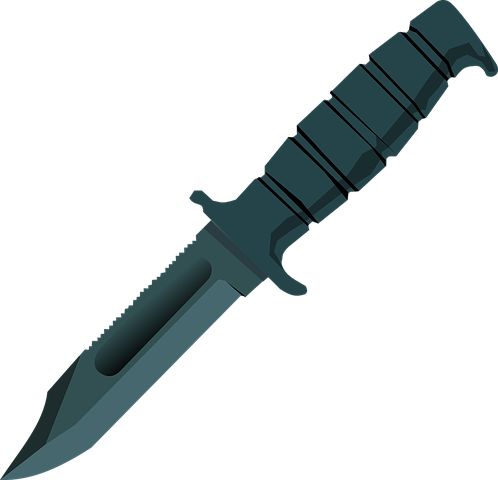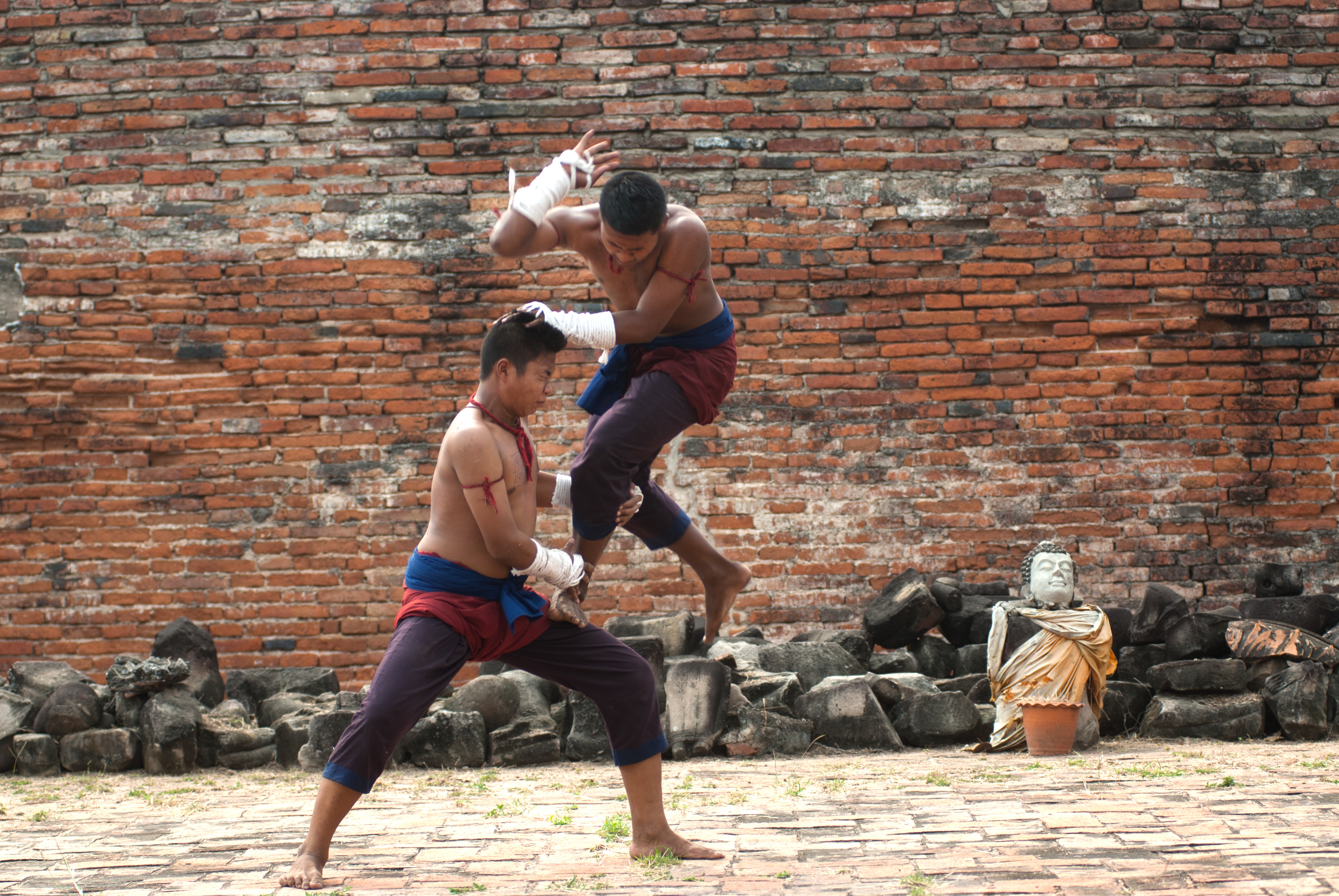Muay thai, as ‘the Art of 8 Limbs’ includes elbows as part of the devastating techniques that make up the art.
In terms of competitive matches in combat sports, muay thai is one of the few that permit the use of elbows.
In kickboxing, boxing, Sanda (Chinese Kickboxing) elbows are not permitted and as such are not trained or practiced much.
In MMA elbows are generally permitted although in the UFC the downward elbow a.ka the ’12 to 6′ elbow is not permitted. Combat sports with the same roots as muay thai such as Khun Khmer (Cambodian boxing) and Lethwei (Burmese Boxing) also allow elbows.
But in terms of making the elbow famous, it is through displays such as in Ong Bak and in muay thai matches that have made the art of elbow strikes well known.
Elbow Technique and Targets
The point of the elbow where the bone sticks out is the main point of contact elbow strikers aim to hit with.
The targets are mostly the jaw (to KO your opponent), forehead and face/eye area (to cut the opponent so they are blinded by their own flowing blood), neck and shoulder (to inflict painful damage) area.
The chest, arms, side of the head and ear area are also potential targets.
Also in an old school muay boran type of attack you can also elbow your opponents leg and thigh area when you catch their kick.
Unlike punches which are driven through, elbows are more ‘poked’ with quick actions that expose the elbow bone to ‘stab’ your opponent.
Think of the elbow strike as like poking and stabbing your opponent with a small sharp knife.

In terms of range, the elbow is a close quarters combat weapon. Usually from inside the clinch or close distance range.
Important to remember though, if you are in range to elbow your opponent, they are also in range to elbow you!
So it’s crucial to keep your opposite hand up by your face and head area to guard against their elbow attack.
Different Types of Elbow Techniques
The elbow strike in muay thai is well developed, originating from muay boran which was a battlefield combat art.
As such there are a variety of elbows used in muay thai. While the point of contact on the pointed bone of your elbow remains the same, the direction the elbow is thrown can vary.
In Muay Thai, the elbow can used horizontally, angles downwards or slashing, upwards, straight spearing motion, downward and spinning.
Below are 6 types of muay thai elbows used in the 6 different elbow motions described above.
There are other elbow variations which include flying elbows among others, but the 6 below are pretty well known in muay thai and are useful for the muay thai practitioner to learn.
- Sok Ti (Slashing Elbow)
- Sok Tad (Horizontal Elbow)
- Sok Ngad (Uppercut Elbow)
- Sok Phung (Forward Elbow Thrust)
- Sok Klap (Spinning Elbow)
- Sok Tong (Downward Chopping Elbow)
Let’s look at each of these elbows strikes in more detail.
Sok Ti (Slashing Elbow)
This is likely one of the most common elbow strikes that is seen and used in muay thai matches. The slashing elbow is thrown diagonally downward in a slashing motion, targeting top of the head and above the eyes, the forehead, and side of the face.
The Sok Ti can be used also to batter your opponents guard and wear it down when they block your strikes. The slashing elbow can be thrown with the lead arm or ear arm.
Sok Tad (Horizontal Elbow)
Another common elbow strike seen in muay thai and even MMA is the horizontal elbow. This is one of the first elbows you will learn when starting out in muay thai, together with sok ti the downward slashing elbow.
Throwing the sok tad, your arm needs to be parallel to the ground, unlike the sok ti which is thrown in a downward direction.
The target area is the lower part of your opponents face and chin area. Again you can use this elbow to batter your opponents guard. This elbow can be thrown either from the lead or rear arm.
Like throwing a wild hook punch, throwing the sok tad can leave you in a over-committed off balance position as you rotate all the way through with your hips and shoulder. It’s important to maintain your balance and stance when using this elbow technique.
Sok Ngad (Uppercut Elbow)
The sok ngad or uppercut elbow is a quick and powerful strike. The fast motion slices like a sharp sword swung in an upward direction.
This elbow is very effective for splitting your opponents guard right up the middle in between his elbows and gloves and aiming for the chin.
You can execute the uppercut elbow form inside the clinch by pummeling to get inside position with your arms and quickly striking upward with this elbow.
You can also execute this elbow from outside the clinch and use the momentum of your forward to step and hip and shoulder action to quickly strike upward.
Either lead or rear elbow can be thrown as sok ngad.
Sok Phung (Forward Thrusting Elbow)
The forward thrusting elbow looks very similar to the uppercut elbow. But the key difference is that the sok phung is ‘stabbed’ forward rather than quickly thrown in an upward motion.
This of it more as like a spearing action straight forward. Like the uppercut elbow it is effective in splitting your opponents guard through the middle.
The sok phung is executed by stepping forward and using this momentum to drive through with your hips while keeping the point of your elbow up and forward like driving a spear into your opponent.
Sok Klab (Spinning Back Elbow)
The sok klab or spinning back elbow is unique in that you give your back to your opponent to throw it. It is almost always the rear elbow that is thrown as it is much more efficient a movement to execute.
To execute this elbow you need to step across your body and rotate your torso to initiate the elbow spinning motion.
You have to be looking at your target from over the shoulder of elbow being thrown. It is best to reverse the motion after striking to return to your stance.
This elbow variation is very unique and a beautiful technique if you can pull it off in the ring.
Sok Tong (Downward Elbow Chop)
Another beautiful technique that is not commonly used but has its roots in muay boran.
In the UFC this type of elbow is not allowed and is referred to as the ’12 to 6′ elbow because of the straight downward motion i.e from 12 o’clock down to 6 o’clock on the old wall clock or analog wrist watch.
The downward elbow has a few variations such as from normal standing stance into your opponents head and face area and jumping to get elevation and striking downward into your opponents head area.
A classic technique is to catch your opponents kick and elbow down into their thigh area.
How to Practice these Elbows
As elbows are very ever rarely used in sparring due to their dangerous nature and risk of injury, they are more likely to be practiced on the heavy bag.
Have a read of a previous post I did here on combos to use in a technical heavy bag session that integrates elbows.
Watch the videos included in this post and other instructional’s online and try them out in a safe manner on the heavy bag.
If you have an experienced instructor or partner you can drill these on the thai pads as well. But take care as these are dangerous techniques.
Only practice with an experienced practitioner and go at 20-30% speed and power until you get the technique down perfectly.



